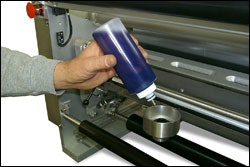
If you seek an overview of food packaging, generously illustrated with nice photography, Innovations in Food Packaging is not for you or any other casual reader.
But if you want the "white lab coat" version of what's happening in food packaging, then you'll find it in this tome, a veritable compendium of food packaging science presented in 517 text-dense pages. "What's happening" is current as of 2003, the most recent citation I could find—book publishing takes some time, especially with an undertaking like this. IFP is a highly formal, authoritative, and above all comprehensively scientific compilation of the subject.
In reality a textbook, IFP is intended for specialists in food packaging, scientists involved in shelf-life and food safety, as well as advanced food science students at universities.
IFP presents the topic with the precision and readability—no more, no less—of a scientific journal, with some black and white pictures along with numerous charts and line art illustrations. Its intent is to educate, not to entertain, and as such, it fulfills its mission.
In doing so, IFP presents diverse technical papers in five major sections: Theories in food packaging; active packaging; modified atmosphere packaging; edible films and coatings; and commercial aspects of new packaging technologies, which wraps things up with a real-world perspective.
Each chapter provides information on the scientific background, new material development and utilization, and case studies of new systems for perishable foods. The papers include the obligatory and exhaustive sourcing that characterizes scholarly publications.
As an editor, I would have liked to see consistent symmetry in the format. In other words, a structure of introduction, explanation, summary, and references. Instead, some papers offer a summary, others have conclusions, some have neither, and others have different headings. However, assembly of this diverse amount of research is a commendable editorial endeavor that eclipses minor criticism like this.
Which brings us to the book's author, or in this case, its editor, on whom the book's value hinges. The qualifications for Jung Han, an assistant professor at the University of Manitoba, are exemplary, having hosted recent food packaging symposia on behalf of the Canadian Institute of Food Science and Technology. In fact, those gatherings inspired Han to collect the papers presented and others into the volume that comprise IFP. Says the author, "I have imposed upon myself an obligation to put the shiny fruits borne in the course of these events in a single basket with a view of extending the network of active packaging specialists." This textbook is a bushel basket of weighty scientific papers.
A test drive
As a test and out of curiosity, I checked the book's authority on three diverse topics: modified atmosphere packaging of fish; time-temperature (freshness) indicators; and oxygen scavengers. Here's what I found:
MAP fish: Several citations, including a 23-page section on preservative packaging of fish and shellfish. A decidedly auspicious start.
TTIs: Found under several consecutively indexed headings, including three pages on "freshness indicators." A solid showing again.
Oxygen scavengers: Yielded 16 citations including a lengthy 15-page section, an impressive finish to my mini-test trio. I'm confident that the results for these diverse topics can be extrapolated across the spectrum of food packaging.
At a list price of $135, the book is a steal, a fraction of the cost to attend one food science or food packaging conference. It will yield much food for thought that you can keep shelved nearby and reference as needed. For food packaging science, this book is a smorgasbord that will keep you content with its detailed content.
For more information or to order, you can visit the book's page at the Elsevier Web site: Innovations in Food Packaging.






















